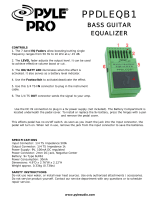
TASCAM DP-32SD 5
Contents
1 – Introduction ..............................................7
Features ..............................................................................................7
Items included with the product ..............................................7
Conventions used in this manual .............................................7
Trademarks........................................................................................8
Precautions for placement and use .........................................8
Beware of condensation ..............................................................8
Cleaning the unit ............................................................................8
About SD cards ................................................................................ 8
Precautions for use ................................................................. 8
User registration ..............................................................................8
2 - Quick Guide ................................................ 9
Playback and mixing .....................................................................9
Preparation ................................................................................9
Listening to the demo song ............................................. 10
Recording and mastering ......................................................... 10
Creating a new song ........................................................... 11
Connecting and setting the input sources ................. 11
Setting the guitar as the recording source for
TRACK 1 ................................................................................... 12
Adjusting and monitoring the input level .................. 12
Recording a guitar to TRACK 1 ........................................ 12
Playing back the recording ............................................... 12
Recording a guitar to TRACK 2 ........................................ 13
Recording a vocal to TRACK 3 .......................................... 13
Mixing the tracks .................................................................. 14
Mastering a recording ........................................................ 15
Shutting down .............................................................................. 16
3 – Names and Functions of Parts ...............17
Top panel ........................................................................................ 17
Display area ............................................................................ 18
Operation buttons ............................................................... 19
Front panel ..................................................................................... 20
Rear panel ....................................................................................... 21
Home screen ................................................................................. 21
Menu structure ............................................................................. 22
Navigating screens ...................................................................... 23
Function button assignments ......................................... 23
Navigation examples .......................................................... 23
4 – Preparation ..............................................24
Inserting and removing SD cards .......................................... 24
Inserting an SD card ............................................................ 24
Removing the card .............................................................. 24
About write-protected SD cards..................................... 24
Powering the unit ........................................................................ 24
Starting up & shutting down ................................................... 25
Starting up the unit ............................................................. 25
Shutting down ...................................................................... 25
Setting the date and time ......................................................... 26
Preparing an SD card for use ................................................... 26
Recorder modes ........................................................................... 26
Connecting other equipment ................................................. 27
Front panel ............................................................................. 27
Rear panel ............................................................................... 27
Adjusting the display ................................................................. 27
5 - Song Management ..................................28
Note for customers using both DP-32SD and
DP-24 units ..................................................................................... 28
Editing names ............................................................................... 28
Loading a song ............................................................................. 28
Creating a new song ................................................................... 29
Saving a song ................................................................................ 29
Viewing song information ........................................................ 30
Copying songs .............................................................................. 30
Erasing songs ................................................................................ 30
Protecting songs .......................................................................... 31
Deleting unnecessary audio data from a song ................. 31
Changing a song name ............................................................. 32
6 - Basic Recording........................................33
Selecting the input sources ..................................................... 33
Assigning inputs .......................................................................... 33
Setting the track type ......................................................... 33
Assigning inputs to mono tracks .................................... 33
Assigning inputs to stereo tracks ................................... 33
Assigning inputs to a stereo bus .................................... 33
Checking assignments ....................................................... 34
Canceling assignments ...................................................... 34
Using phantom power ............................................................... 34
Monitoring ..................................................................................... 34
Monitor selection ................................................................. 34
OL indicators and level meters ............................................... 34
Peak hold display ................................................................. 35
Mixer screen settings ................................................................. 35
Using the input equalizer .................................................. 35
DIGITAL TRIM setting (track only) ................................... 36
Sending signals to internal/external effects .............. 36
Enabling insert effects ........................................................ 36
Setting the stereo position ............................................... 37
Changing the signal phase ............................................... 37
Checking the fader level .................................................... 37
Setting levels sent to stereo buses ................................ 37
Solo ................................................................................................... 37
Muting tracks ................................................................................ 37
Rehearsing a recording ............................................................. 38
Making the first recording ........................................................ 38
Multitrack recording ................................................................... 38
Arming tracks for recording ............................................. 38
Adjusting track pan and level settings ......................... 38
Input selection and assignment ..................................... 38
Setting input levels.............................................................. 39
Recording ................................................................................ 39
Undoing an operation ............................................................... 39
Undo feature settings ......................................................... 39
Undoing the last operation (single undo) ................... 39
Undoing older operations (multiple undo) ................ 40
7 - Recorder Functions ..................................41
Punching in and out ................................................................... 41
Using a footswitch to punch in/out .............................. 41
Setting the footswitch ........................................................ 41
Bouncing tracks ............................................................................ 41
Using the bounce function ............................................... 42
Checking the bounce result ............................................. 42
Direct location function ............................................................ 42
Locating a specified time directly .................................. 42




















